Pemphigus IgG causes skin splitting in the presence of both desmoglein 1 and desmoglein 3
- PMID: 17640963
- PMCID: PMC1959479
- DOI: 10.2353/ajpath.2007.070028
Pemphigus IgG causes skin splitting in the presence of both desmoglein 1 and desmoglein 3
Abstract
According to the desmoglein (Dsg) compensation concept, different epidermal cleavage planes observed in pemphigus vulgaris and pemphigus foliaceus have been proposed to be caused by different autoantibody profiles against the desmosomal proteins Dsg 1 and Dsg 3. According to this model, Dsg 1 autoantibodies would only lead to epidermal splitting in those epidermal layers in which no Dsg 3 is present to compensate for the functional loss of Dsg 1. We provide evidence that both pemphigus foliaceus-IgG containing Dsg 1- but not Dsg 3-specific antibodies and pemphigus vulgaris-IgG with antibodies to Dsg 1 and Dsg 3 were equally effective in causing epidermal splitting in human skin and keratinocyte dissociation in vitro. These effects were present where keratinocytes expressed both Dsg 1 and Dsg 3, demonstrating that Dsg 3 does not compensate for Dsg 1 inactivation. Rather, the cleavage plane in intact human skin caused by pemphigus autoantibodies was similar to the plane of keratinocyte dissociation in response to toxin B-mediated inactivation of Rho GTPases. Because we recently demonstrated that pemphigus-IgG causes epidermal splitting by inhibition of Rho A, we propose that Rho GTPase inactivation contributes to the mechanisms accounting for the cleavage plane in pemphigus skin splitting.
Figures

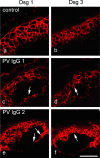
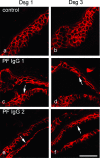
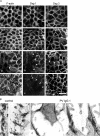

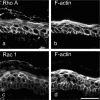
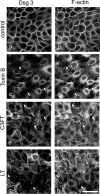

Similar articles
-
Inhibition of Rho A activity causes pemphigus skin blistering.J Cell Biol. 2006 Dec 4;175(5):721-7. doi: 10.1083/jcb.200605125. Epub 2006 Nov 27. J Cell Biol. 2006. PMID: 17130286 Free PMC article.
-
Pemphigus vulgaris IgG directly inhibit desmoglein 3-mediated transinteraction.J Immunol. 2008 Aug 1;181(3):1825-34. doi: 10.4049/jimmunol.181.3.1825. J Immunol. 2008. PMID: 18641320
-
IgG-induced clustering of desmogleins 1 and 3 in skin of patients with pemphigus fits with the desmoglein nonassembly depletion hypothesis.Br J Dermatol. 2011 Sep;165(3):552-62. doi: 10.1111/j.1365-2133.2011.10463.x. Br J Dermatol. 2011. PMID: 21692763
-
Pemphigus vulgaris: recent advances in our understanding of its pathogenesis.Minerva Stomatol. 2007 Apr;56(4):215-23. Minerva Stomatol. 2007. PMID: 17452959 Review. English, Italian.
-
Immune dysregulation of pemphigus in humans and mice.J Dermatol. 2010 Mar;37(3):205-13. doi: 10.1111/j.1346-8138.2009.00797.x. J Dermatol. 2010. PMID: 20507383 Review.
Cited by
-
Desmoglein 3 acting as an upstream regulator of Rho GTPases, Rac-1/Cdc42 in the regulation of actin organisation and dynamics.Exp Cell Res. 2012 Nov 1;318(18):2269-83. doi: 10.1016/j.yexcr.2012.07.002. Epub 2012 Jul 13. Exp Cell Res. 2012. PMID: 22796473 Free PMC article.
-
Peptides Targeting the Desmoglein 3 Adhesive Interface Prevent Autoantibody-induced Acantholysis in Pemphigus.J Biol Chem. 2009 Mar 27;284(13):8589-95. doi: 10.1074/jbc.M808813200. Epub 2009 Jan 21. J Biol Chem. 2009. PMID: 19164289 Free PMC article.
-
Loss of Desmoglein Binding Is Not Sufficient for Keratinocyte Dissociation in Pemphigus.J Invest Dermatol. 2015 Dec;135(12):3068-3077. doi: 10.1038/jid.2015.324. Epub 2015 Aug 19. J Invest Dermatol. 2015. PMID: 26288352
-
The extent of desmoglein 3 depletion in pemphigus vulgaris is dependent on Ca(2+)-induced differentiation: a role in suprabasal epidermal skin splitting?Am J Pathol. 2011 Oct;179(4):1905-16. doi: 10.1016/j.ajpath.2011.06.043. Epub 2011 Aug 22. Am J Pathol. 2011. PMID: 21864491 Free PMC article.
-
Desmocollin 3-mediated binding is crucial for keratinocyte cohesion and is impaired in pemphigus.J Biol Chem. 2009 Oct 30;284(44):30556-64. doi: 10.1074/jbc.M109.024810. Epub 2009 Aug 28. J Biol Chem. 2009. PMID: 19717567 Free PMC article.
References
-
- Amagai M. Desmoglein as a target in autoimmunity and infection. J Am Acad Dermatol. 2003;48:244–252. - PubMed
-
- Amagai M, Ahmed AR, Kitajima Y, Bystryn JC, Milner Y, Gniadecki R, Hertl M, Pincelli C, Fridkis-Hareli M, Aoyama Y, Frusic-Zlotkin M, Muller E, David M, Mimouni D, Vind-Kezunovic D, Michel B, Mahoney M, Grando S. Are desmoglein autoantibodies essential for the immunopathogenesis of pemphigus vulgaris, or just “witnesses of disease”? Exp Dermatol. 2006;15:815. - PubMed
-
- Payne AS, Hanakawa Y, Amagai M, Stanley JR. Desmosomes and disease: pemphigus and bullous impetigo. Curr Opin Cell Biol. 2004;16:536–543. - PubMed
-
- Stanley JR, Amagai M. Pemphigus, bullous impetigo, and the staphylococcal scalded-skin syndrome. N Engl J Med. 2006;355:1800–1810. - PubMed
-
- Grando SA. Cholinergic control of epidermal cohesion. Exp Dermatol. 2006;15:265–282. - PubMed
Publication types
MeSH terms
Substances
LinkOut - more resources
Full Text Sources
Medical
Miscellaneous

